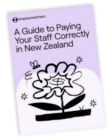
At the heart of any business is the employees. Whether you’re a massive corporation or a small enterprise, every employee in your business will be getting a wage or salary. That means, if we’re continuing our heart analogy, payroll acts as the pulse of your business.
For many people who run a small business, they didn’t start their company as an expert in all things business. More often than not, they’ve found a product or a market niche and started gradually. Payroll is often something that is learned quickly as the business begins to take on employees and it’s crucial to get it right, even on the fly.
Don’t worry – we’re here to help you get started. Here’s our overview of setting up payroll in your small business.
What does the payroll process look like for Kiwi businesses?
The payroll process begins with some groundwork where you understand what you have to consider from a legal point of view and what will be required of your business. Then, it’s all about gathering the right information and putting everything into place. Let’s begin…
Step 1: Understand the legal requirements in New Zealand
Running payroll is compulsory for all New Zealand based employers, but it also must be done compliantly. There are a few key legal requirements that every employer should adhere to.
The Essential Guide to HR Compliance in New Zealand
You must pay the minimum wage or above to all employees aged 16 and over
All employees who are aged 16 and over must be paid the minimum wage. There are three types of minimum wage to consider – most employees will be eligible for the ‘adult’ minimum wage, which is currently $23.15 per hour.
The exceptions are those who classify for the ‘training’ or ‘starting out’ minimum wage. The ‘training’ wage is for employees who are in an industry training programme, while the ‘starting out’ minimum wage is for 16 and 17 year old employees who haven’t yet completed six months of continuous employment. Each of these wages come to $18.52 per hour.
You must keep wages and time records for all employees for at least six years
It’s a legal requirement that all employers keep comprehensive records, including wages, time records, holiday and leave records.
These records can be kept on paper or electronically, and need to cover the last six years of operation. Employers should also have a signed copy of every employment agreement for all their employees on file.
You must make the deductions permitted under the Wages Protection Act 1983
This one can be tricky to get your head around, especially as an employer who is new to payroll. However, it’s essential to know exactly which deductions you should be taking from wages with every pay run.
Whether that’s PAYE deductions, KiwiSaver, child support or student loan payments. It may vary a little by employee as well, so make sure you’ve done your due diligence. It’s also important to note that any deductions that aren’t permitted under the Wages Protection Act are deemed illegal.

Step 2: Gather essential employee information
Ok – so you’ve got an understanding of your basic commitments as an employer when it comes to payroll. Next, it’s time to get the ball rolling. You’ll need to collect the following information from all employees to calculate pay correctly for your business.
Employee tax code
Ask your employee to complete a tax code declaration IR330 form. This form includes a flow chart which will guide the employee towards choosing the correct tax code for them.
Once they’ve filled in the form, you should add it to your employer records and use the code for making the correct tax deductions.
KiwiSaver information and chosen contributions
As a work-based scheme, it’s the responsibility of employers to check whether their employees are enrolled in KiwiSaver or if they’re exempt (this usually applies to those on temporary or student visas).
If they’re enrolled already, ask your new employee to fill in a KiwiSaver deduction form where they’ll be able to fill in the KiwiSaver contributions they want to make from their pay in their current role.
Otherwise, if they’re new to KiwiSaver, make sure to give them all the key enrollment information as well as ask for their chosen contribution level.
Employee payment details
All employees should be paid in cash, but the method of payment can vary eg. bank transfer or cheques.
As an employer, your employment agreement with your new employee should specify the frequency of pay runs, and when they will happen. This is usually every week, fortnight or month. In turn, you should ensure you have the information you need to pay them – for example, their bank account details or home address.

Step 3: Set up a small business payroll account
Next up, it’s time to link up everything you have so far with Inland Revenue. Start by registering as an employer on their website, and create a specific myIR account for your business.
You will have to register the number of employees you have. It’s also crucial that you’re across each employee with a file containing the key information you’ve gathered in step 2. Payroll software can be a useful way to do this, as a single digital space to keep everything filed accurately. Any further new employees should also be registered with Inland Revenue on or before their first payday.
Step 4: Time for payday filing
Your chosen payday has come around and it’s time to pay your employees. This means you’ll be calculating any deductions from pay and then providing employees with their final take-home pay. Employment NZ recommends that you also give your employees payslips so you’re both on the same page, although it’s not compulsory.
That action should always be accompanied by payday filing. This means you’re providing Inland Revenue with accurate information about each employee on your business payroll, including the selected payday, deductions and the pay period that the employee has worked. You should also report your gross taxable earnings. It can either be done electronically or by paper.
For electronic filing, you must send the relevant Employment Information within two working days of each payday.
For paper filing, you must file within 10 working days of each payday.
Guide to Payroll in New Zealand
Processing payroll with a payroll software
If this all sounds like a lot – you’re not wrong, it is! Running payroll is a key part of running a business and it’s critically important to get it right.
One way to speed up the process and make it less time-consuming is with payroll software. With employee self-service features, you can ask employees to submit everything needed in step 2 of our blog, saving you a ton of time organising information.
Payroll software uses that information, as well as time worked and designated wages to effectively set up the right pay rules for you. Some (like Employment Hero Payroll) may even come with automatic payroll reporting to Inland Revenue.
We know as a small business owner, you’re probably very stretched for time. Why not make payroll simple and enjoy one less headache? Speak to our team about how our payroll software can support your small business.

FAQs
Do I need payroll for my small business?
If you’re employing someone as part of your business, then yes! It’s a legal requirement to pay employees in a compliant manner, and that means running payroll.
Do I need payroll for one employee?
Yes, if you employ a single employee in your business, you should still register with Inland Revenue and run payroll. This applies whether you have 100 employees or just one – although naturally the more people you employ, the more complicated it can get.
Can I do my own payroll for my small business?
You can, but it’s key that you’re taking the right steps. After all, the consequences of inaccurate pay can be severe, with fines well into the five figures. This blog is just an overview so consider bringing in support to help you get comfortable with the process. This could be in the form of an accountant, managed payroll services or digital support through payroll software.
Disclaimer: The information in this article is current as at 2 April 2024, and has been prepared by Employment Hero Pty Ltd (ABN 11 160 047 709) and its related bodies corporate (Employment Hero). The views expressed in this article are general information only, are provided in good faith to assist employers and their employees, and should not be relied on as professional advice. The Information is based on data supplied by third parties. While such data is believed to be accurate, it has not been independently verified and no warranties are given that it is complete, accurate, up to date or fit for the purpose for which it is required. Employment Hero does not accept responsibility for any inaccuracy in such data and is not liable for any loss or damages arising either directly or indirectly as a result of reliance on, use of or inability to use any information provided in this article. You should undertake your own research and to seek professional advice before making any decisions or relying on the information in this article.



